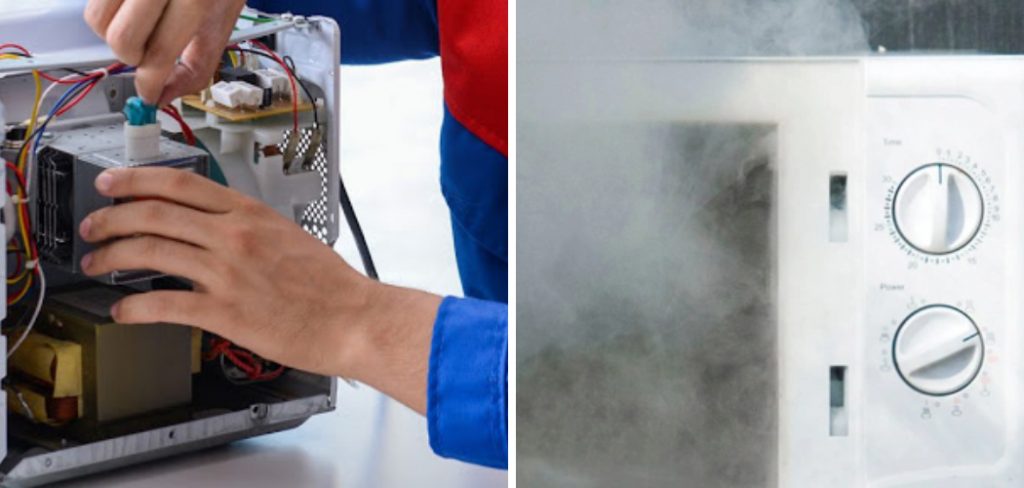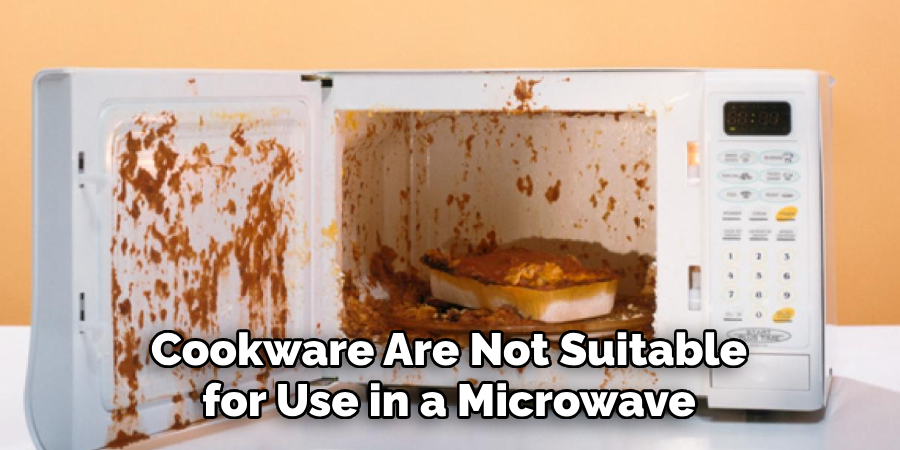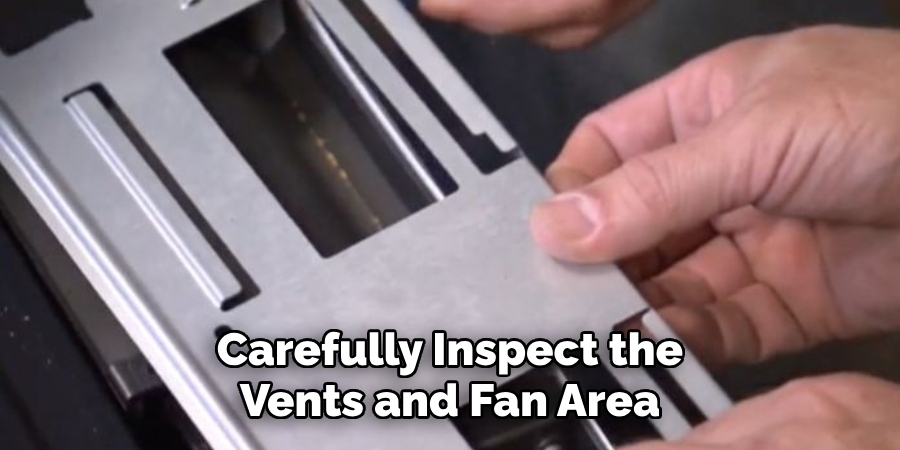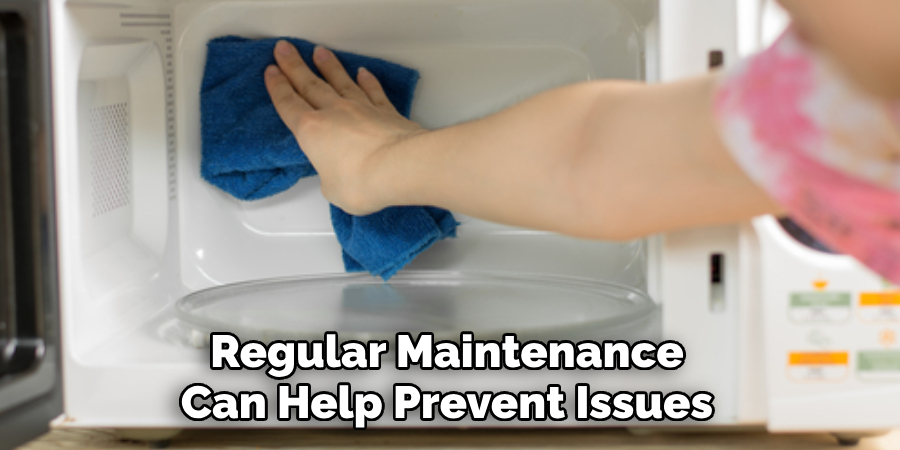Are you frustrated with your microwave that seems to never cool down? Have you had enough of burning food or having to hold the door open so it won’t get too hot? We understand how exasperating a malfunctioning and overheated appliance can be, but don’t despair – there is an easy solution!

In this blog post, we’ll provide a comprehensive guide on how to fix overheated microwave while quickly restoring it back into optimal working order. Though solving your issue may seem complicated at first, our step-by-step instructions will make the process simple and help you get back to cooking delicious meals in no time!
Why Does Microwave Overheated?
1 . Blockage of Microwave Vents
A microwave is equipped with vents that serve as an outlet for heat generated while cooking food. These vents are usually located at the back or top of the appliance. When these vents get clogged due to dust, dirt or debris, the airflow gets restricted and the heat remains trapped inside, resulting in overheating.
2 . Faulty Thermostat
The thermostat is a device that regulates the temperature inside a microwave. If it gets faulty, it may fail to regulate the temperature properly and cause overheating. This can happen due to wear and tear or malfunctioning of the thermostat.
3 . Malfunctioning Magnetron
The magnetron is a crucial component that generates microwave radiation, which heats up the food. If it gets damaged or malfunctions, it may cause overheating in the appliance. This can happen due to age, excessive use or power surges.
4 . Damaged Door Seal
The door seal helps keep the heat inside the microwave and prevents any leakage. If it gets damaged, it can result in heat escaping and causing overheating. This can happen if the seal is old, worn out or has been accidentally damaged.
5 . Incorrect Use of Cookware
Certain types of cookware are not suitable for use in a microwave and can cause overheating. For example, metal cookware with sharp edges or reflective surfaces can cause sparks and overheating. It is important to use only microwave-safe cookware in order to avoid this issue.

6 . Overloading the Microwave
Putting too much food in the microwave at once can also cause it to overheat. This happens because the appliance has to work harder and use more energy to heat up a larger quantity of food. It is advisable to follow the recommended guidelines for cooking and not overload the microwave.
7 . Faulty Power Supply
In some cases, overheating may occur due to faulty power supply. This can happen if there are electrical issues within the appliance itself or if there are problems with the outlet or wiring. It is important to get these issues fixed by a professional in order to prevent any further damage and potential safety hazards.
How to Fix Overheated Microwave in 5 Easy Steps
Step 1: Unplug the Microwave
If your microwave starts overheating, it is important to immediately unplug it. This will prevent any further damage and potential fire hazards.
Step 2: Allow the Microwave to Cool Down
After unplugging the microwave, allow it to cool down for at least 15 minutes before attempting to fix it. This will ensure that you do not get burned while trying to fix the problem.
Step 3: Check for Blockages or Debris
Once the microwave has cooled down, carefully inspect the vents and fan area for any blockages or debris. If there are any, remove them using a soft cloth or vacuum cleaner. These blockages can often cause overheating by preventing proper air flow.

Step 4: Reset the Microwave
After checking for blockages, plug the microwave back in and reset it. This can usually be done by pressing the “Reset” button or unplugging the microwave again for a few seconds before plugging it back in.
Step 5: Test the Microwave
Finally, test the microwave to see if it is functioning properly. Be sure to place a cup of water inside and run it for a few seconds. If you do not notice any further overheating, then your microwave should be fixed and ready to use again.
Remember, prevention is key when it comes to avoiding an overheated microwave. Always make sure to keep vents and fans clean and clear of any debris, avoid using metal containers or utensils in the microwave, and never operate the microwave when it is empty.
Additional Tips
1 . Know the Warning Signs
It is important to know the warning signs of an overheated microwave so that you can take action before it causes any serious damage. Some common signs include unusual noises, a burning smell, or sparks inside the microwave.
2 . Don’t Attempt Repairs Yourself
While some minor fixes can be done at home, it is always best to seek professional help when dealing with an overheating microwave. Trying to fix it yourself may result in further damage or injury if not done correctly.
3 . Consider Regular Maintenance
Just like any other appliance, regular maintenance can help prevent issues with your microwave. This could include cleaning and inspecting vents and fans, as well as checking for any loose connections or faulty parts.

4 . Replace Old or Faulty Parts
If you notice any old or faulty parts during your maintenance check, it is important to replace them as soon as possible. This will not only prevent overheating but also ensure the safe and efficient use of your microwave.
5 . Always Follow Manufacturer’s Instructions
Lastly, always make sure to read and follow the manufacturer’s instructions for proper use and care of your microwave. This can help prevent any potential issues and extend the lifespan of your appliance.
Following these simple steps and tips can help you fix an overheated microwave quickly and safely. Remember to always prioritize safety when dealing with any appliance issue.
Frequently Asked Questions
What Precautions Can Be Taken to Avoid an Overheated Microwave?
Microwaves are an essential part of modern kitchens, but they can become overheated if not used correctly. Here are some precautions you can take to avoid an overheated microwave: Make sure the dishes and containers you are using in the microwave are labeled as “microwave safe”.
These containers are designed to withstand high temperatures without melting or releasing harmful chemicals. Always use the designated microwave-safe cookware for cooking or heating food.
Additionally, avoid using aluminum foil, metal utensils, or dishes with metallic paint or designs as they can cause sparks and damage to your microwave. It is also essential to regularly clean the inside of your microwave from any food residue that could potentially catch fire.
How Do I Know If My Microwave is Overheating?
One of the most obvious signs of an overheated microwave is when it shuts off in the middle of a cooking cycle. This could be due to an internal thermostat that has been triggered by excessive heat. Another way to tell if your microwave is overheating is by smelling a burning odor coming from it while in use. If you notice any of these signs, it is crucial to turn off and unplug your microwave immediately.
How Do I Fix an Overheated Microwave?
If your microwave has overheated, the first step is to let it cool down completely. Once cooled, make sure to clean the inside of the microwave thoroughly and remove any debris or food particles that could be causing the issue. If the problem persists, you may need to check if there are any damaged parts or contact a professional for repairs.
Can an Overheated Microwave Be Dangerous?
Yes, an overheated microwave can be dangerous as it can potentially cause a fire. It is essential to take proper precautions when using a microwave and never leave it unattended while in use. It is also important to properly maintain and clean your microwave to prevent any potential hazards.

Can I Prevent My Microwave From Overheating?
Yes, there are several ways to prevent your microwave from overheating. These include using designated microwave-safe cookware, avoiding metal or foil in the microwave, and regularly cleaning the inside for any food residue. It is also essential to follow cooking instructions and avoid overcooking or heating food for extended periods.
Additionally, make sure that your microwave has proper ventilation and is not placed too close to other appliances or objects that could block air circulation. By following these precautions, you can help prolong the lifespan of your microwave and prevent potential hazards caused by overheating. Remember to always use caution when operating a microwave and never ignore signs of an overheated appliance.
Conclusion
Overall, overheating your microwave can be a serious issue if not addressed appropriately. Utilizing good maintenance habits such as cleaning, keeping the exhaust open, and replacing parts when necessary will go a long way to preventing an overheating issue.
If you still find that your microwave is becoming too hot while in use, it’s highly recommended to take the necessary precautions described in this blog post as soon as possible, not only for the sake of the machine itself but for safety reasons as well. Nobody wants their kitchen catching on fire from leaving a small problem at hand unchecked.
Now you know how to fix overheated microwave! Keeping up with regular maintenance habits for your appliance will keep your cooking area safe and ensure that you get years of optimal performance from your microwave. Don’t forget to call upon a qualified repair technician if needed to keep your meals cooked correctly!
